Individual Project – Ember Fu
Note: I believe my game is better played blind, though note that as of this posting/current time, while you can play through all routes in this iteration, the writing is not in-depth for every character path. Thus it is highly recommended to choose Jonah as your main route when offered the choice. Simply ensure you don’t ignore/leave any character encounters and select Jonah when offered.
link and password is cs377g
Premise & Overview
Warning: SPOILERS!!! Play game before reading and see note above.
Comrade is a story about playing the Hero in a classic fantasy setting, the sort of generic but lively world that follows the old conventions and tales of mages, swords, and you, the chosen one, fighting demons to save the world. But the dystopic world of Fanta Terra is built on these tropes made real into darker, iron-fist rules, enforced by some unknown power. Subverting the hero arc of becoming stronger when overcoming strife, such as fallen comrades, you play as the Hero bestowed a power that can quite literally only be activated upon the death of the very party members you recruit. You must follow your missions, and you can’t save the world without using your power.

(Image of start of game, bg credit to https://www.oxpal.com/medieval-town-map.html)
At its core, then, Comrade is about playing a tumultuous hero handling their toxic internal feelings in the face of incredible strife with no clear answer, which at this point has also left them averse to connection. It’s about wrestling with what you know and feel to be ethical while under mental stress, holding onto your morality and your faith in yourself and others. Even if you’ve done terrible things or aren’t a moral paragon yourself, for reasons that aren’t entirely your fault. And of course, it’s about some gruesome and darker moments that blot the regular, storybook-like hero’s journey. The lore of Fanta Terra is never quite explicitly outlined for you, but tidbits are scattered in the story and multiple routes to allow you to come to your own conclusions.
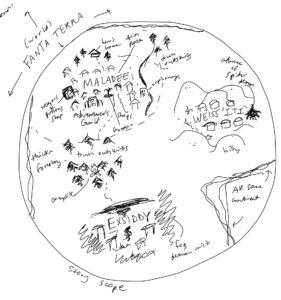 (Sketchy early map of the locations in the world and events)
(Sketchy early map of the locations in the world and events)
The journey the player takes through this path follows a general three-act structure. In the first, the player gets a feel for the world but will grow more suspicious through the narrative. In the following act, the player now understands the true premise of the game, and becomes more occupied with making important choices revolving around the themes as they navigate the story. In the last, final confrontations are had and mysteries are revealed, though not completely elucidated. The closure here is less about the finality of Fanta Terra, and more about the arc the Hero goes through to reach this point at all; bonds and endings are left somewhat ambiguous to imply that there has simply been a start or change. Throughout, the plot unfolds through largely narration of the Hero’s internal feelings and the events that happen, but also through dialogue, choices, and character interaction.
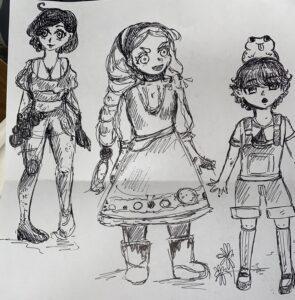
(Early character sketches of Mirian, Lori, and Jonah)
My goal was for players to understand these themes of morality and the role companionship has in breaking out of toxic behavior (or at least starting to!). I also wanted, through the many unique allies you can recruit and grow closer to, to show off many very different but connected perspectives that can lead to similar insecurities, feelings of self-doubt and hopelessness, and the internal closing-off to connection. These were to be interesting characters with meaningful stories, and to imply that there are stories beyond the Hero you primarily play in Comrade.
For instance, some characters such as Jonah, feel like outsiders for various reasons and rationalize their loneliness; others distrust others due to past experiences; others still come from the other side of being unable to help with their friend that do not want to be helped. Self loathing and toxic mindsets/behaviors can sprout from any and all of these. While due to time constraints I couldn’t explore these in the breadth and depth I wanted to, most of Jonah’s arc is included and the other characters have the groundwork laid.
(All the character sketches I later did, ideally to be made into sprites for the game)
This process of adding as I worked through what I already had was how I developed much of Comrade. I tend to think big and as I work through thoughts, sprout many many tangents. It can get unwieldy and lose direction, so I am very much a planner regarding later stages where I fully outline my story. In the earlier process, I noted any tangents I thought of in my phone, and got a feel for the style and characters more loosely through sketches. In general, developing Comrade began with brainstorming and iterating on this idea that I had long had on a back-burner of story ideas.
Playtesting
Playtest #1
My first playtest was a very rough conceptual walk-through where I described the story premise and took Tester 1 through the story beats as the Hero protagonist. I walked through each route I had brainstormed at this point, starting with the alternate or “bad” endings where the Hero dies in various ways due to various combinations of choices. For instance, continuing to slaughter and giving up morally lead to the Hero either becoming a renowned but cruel hero that dies dissatisfied and empty, or being executed due to others uncovering their trend of ally-slaughter. This split same-route ending depended on how well the Hero would establish relations with the town. T1 thought this extra layer added depth to the minor choices, so I carried this mechanic through to the final iteration.
Some critical feedback I received at this stage, however, involved balancing the story plot points with clarity of theme. For instance, the “defying your contract” route at this stage also led to the Hero’s death and was initially planned as another “bad” ending. This was a bit confusing to T1 as it felt like there was nothing the Hero could do, and it seemed counter to the idea that they needed to break out of a toxic cycle. I was able to rework this to more coherently pipeline into the “true” ending, but such that there are still severe tradeoffs and the goodness of the route retains room for ambiguity.
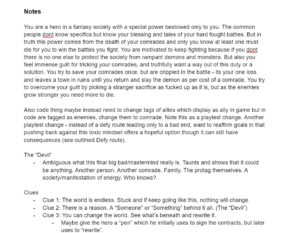
(My initial notes, written on phone notes and later moved to a Google doc)
I was also able to nail down the ending I had in mind. Originally, I wanted the final confrontation to involve the Hero “rewriting” the un-killable ‘big bad’ from enemy to comrade, calling back to their original ability to kill their comrades to save the day. While this was a cool tie-in to the lore, I agreed with T1 in how this felt confusing for my message. Is the answer just killing your friends? Certainly not. To solve this, I thought more about why the story beat felt right, but the execution felt off. I realized that it was because to the Hero, they were turning against the power they had been relying on/tied to at this point. In this sense, the “big bad” was, despite the Hero’s trepidations and anger toward it, their actual “comrade” throughout the story, and it is only at the end that the Hero recognizes the toxic nature of their relationship and the need to break free. So, I reworked this mechanic by flipping it so the Hero rewrites the people they once distrusted and closed off to (“enemies” in a sense) into true comrades, and the Devil from “comrade” into enemy.
Playtest #2
My second playtest still did not have the game in a playable digital state (to be coded in Renpy). Instead, I had a fully-fleshed out and highly detailed outline of the story, routes, choices, and structure, and a sprinkle of narrative flavor. For Tester #2, I playtested this by doing down my outline in front of me and playing pseudo-narrator. For instance, I would read the story beat (and add a bit of narrative flair verbally, on the fly) and present three verbal choices alongside gestures in the air. T2 gave positive feedback regarding my now narrowed concept, and critiqued more towards the structure of the game itself.
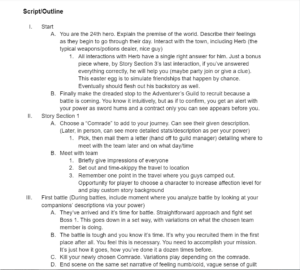
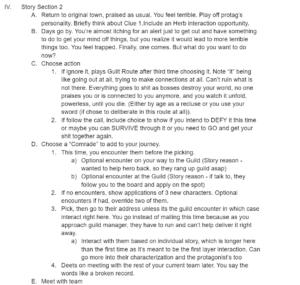 (the first half of my very long, very detailed outline)
(the first half of my very long, very detailed outline)
The main feedback was that some of the development in the first act felt like it was taking a little too long before the player finally gets into the meat of it–the first choice of killing a comrade. T2 talked about how this choice really sets the tone for the story going forward and that the bulk of the story may need to be less evenly distributed across the acts. In response, I reviewed my outline and rearranged several points, shifting more bonding moments and interactions into the second act, and thinning out the first act to what was truly important.
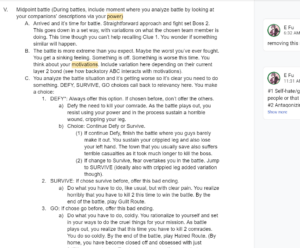
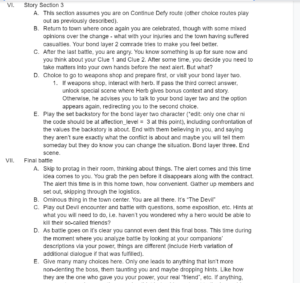
(the second half of my again, quite in-depth outline)
Playtest #3
Finally, my third playtest was a fully functioning Renpy game prototype, which I uploaded to itch.io for my remote Tester #3 to download and run while screen-sharing. I was happy to see T3 really engage with the story and have visceral reactions to the darker story points. Through this complete playthrough of 2 routes (dying of guilt as a bad ending, and finishing the true ending), I was able to catch minor errors in language or things like too much text in one section, and make the appropriate ameliorations. Other notes were useful positive affirmations, such as the intrigue of the premise, the impression of the Hero (a “prick”, as T3 put it!), and the coolness of the final twist while still being easy enough to figure out without prompting.
An important confusion I did discover in this playthrough was that T3 was initially quite confused as to why the Hero had to do such terrible things. By the second contract, they understood more, but were still a little confused on why exactly they needed to kill their allies to save the world. In response, I decided to make things a little more explicit by the second contract, so that the rules written for the Hero are also more directly informed to the player.
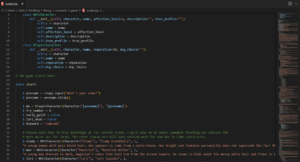
(a little peek into the code and script of the game)
Overall, I revised my feedback in narrower stages starting with conceptual decisions, which I used to determine the final outline of the game. Then, structural shifts, which I then could use to better visualize and write character arcs and narrative. Finally, polishing and improving the final prototype’s smaller errors as well as brushing up player confusions. Together, I believe this made for a more thematically directed, smoother-flowing, and clearer game.
Reflection
Throughout this post, I’ve reflected on the game, my process, my visions and my revisions. Altogether, I would put this succinctly as:
- I did create a “dark hero’s journey” game involving multiple nuanced routes and lots (lots!) of narrative pieces.
- I learned that these themes can be very difficult to manage, execute in depth, and interweave together, and they can be highlighted powerfully through having players make juicy, important decisions.
- Next time, I’d do it so that my scope is shrunk farther and cut out even more tangents, so that I can build an extremely solid, if simpler foundation that I can then expand and build more complex parts into later.
There were so many more things I wanted to do with Comrade, ranging from fleshing out all the characters and diving deeper into the narrative. I think there are many many differing stories and reasons that lead people to the same path of distrust and disbelief in oneself, others, making connections, and it leads us to compromise our values. This is what I wanted to express with Comrade, and while the heart is there, I think my current prototype can be so much more. Overall, I truly enjoyed making this game.
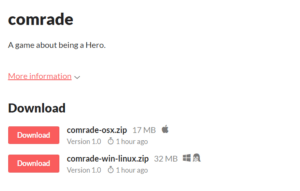
(my cute little itch.io page for the game, that betrays nothing to a new player!)


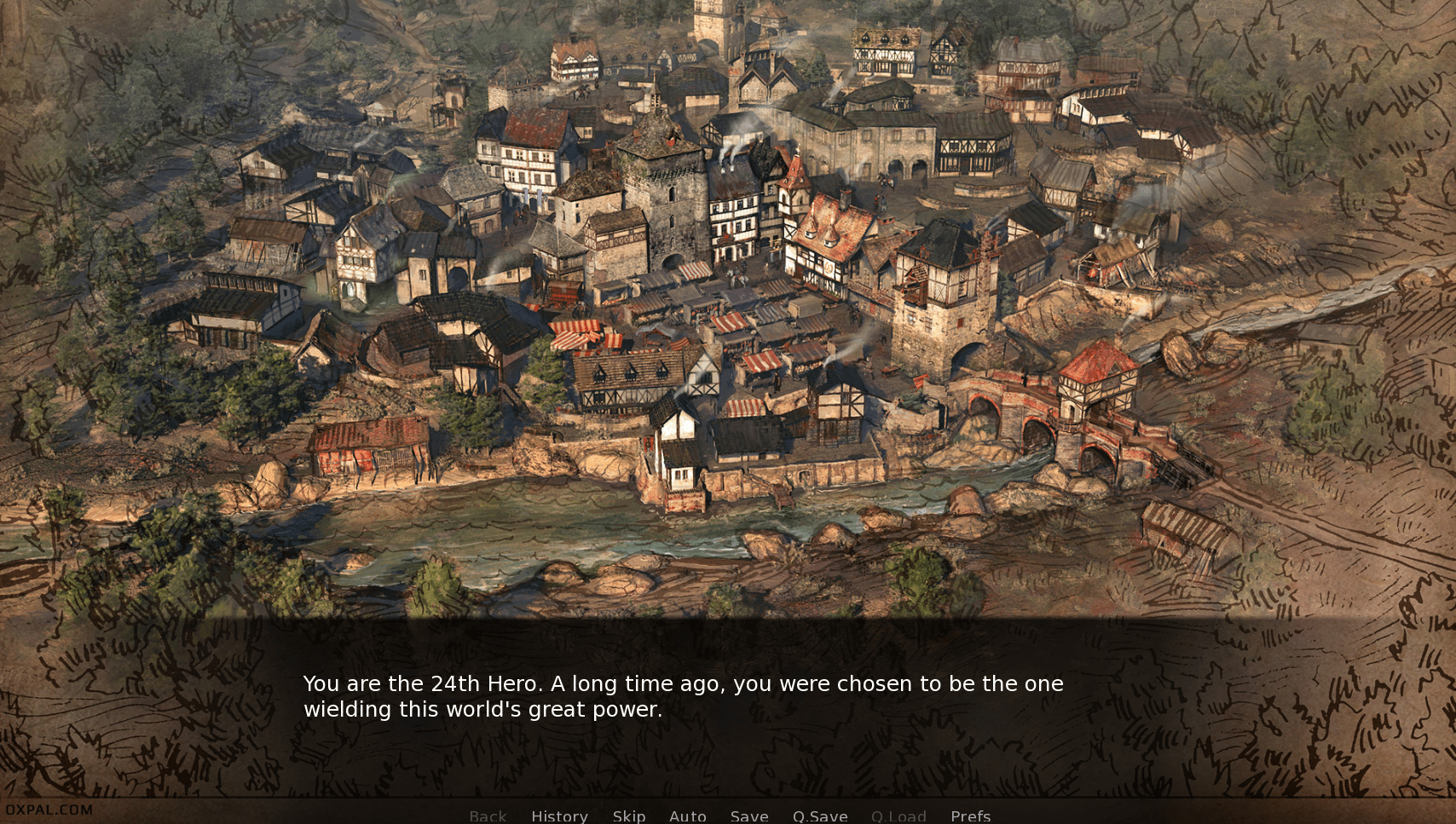

I enjoyed this a lot. I like the visuals of the story. The protagonist definitely had a very particular grumpy personality but I related to them so I felt very immersed. The story had me hooked the whole way through and I did not expect the twist.
Some of the principal values I found in the game are mystery, morality (in a trolley problem sort of way), and duty. At first, the game merely hints that something sinister is afoot. During my first playthrough, I surmised from the hero’s jaded and disaffected tone that their comrades wouldn’t make it back in one piece. Incidentally, I foresaw the twist that the player would have to kill at least one of them, but I think this is a sign of good writing, as there was sufficient foreshadowing present to make the action less jarring. In any case, there was an emphasis on mystery, at least during the first playthrough, which totally hooked me and immersed me in a fantasy universe full of familiar tropes (I’m a fan of fantasy so I see this as a good thing as well). After the player kills his comrades, the game emphasizes morality and duty. The player is presented with a choice to continue slaying demons at the expense of a few zealous adventurers, or rid themselves of the responsibility by essentially ignoring the problem. In such a way, the game forces the player to contend with the moral dilemma of sacrificing a few to save many. The stakes of the choice become even greater when we introduce the fact that the hero is the only being with the power to kill these demons; a unique duty is cast upon them and they must choose to meet this grim duty or ignore it at the expense of everyone else.
The game had me immersed from the get-go. I enjoy the protagonist’s inner narration and his struggle is interesting enough to get me to care about the game’s topic and world. I think the game used the IF medium to full effect. The designer focused on building a world that forces compelling decisions upon the player. The magnitude of the aftermath of the player’s choices helped in making the choices feel interesting. They present an objectively massive consequence on the game’s world, thereby feeling consequential.
Being given the choice of companion to bring on the mission immediately made me care more deeply about the world. It made it feel like the world was populated by many adventurers going on all sorts of different quests and our band is but one group of mercenaries contending with the world’s many dangers. Then being forced to kill this companion made the action of killing your comrade all the more impactful.
I think the game works great as a sort of “short story” IF. For P4 I would focus on either adding more content to the story or, perhaps preferably, adding a sort of unrelated episode 2 with different characters but in the same world, given the strong worldbuilding already present here. Other than that, I think the writing could use refinement; make it more punchy, active voice, flowing rhythmic sentences, etc.